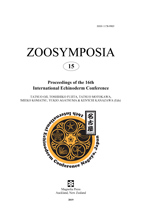Abstract
Irregular echinoids, particularly clypeasteroids or “sand dollars”, have obtained highly adaptive morphologies suited to their life habitats. Specimens (n = 26) of a clypeasteroid echinoid Arachnoides placenta were examined to understand how these adaptive morphologies were ontogenetically and developmentally obtained. Ontogenetically, early post-larval juvenile specimens have a pentagonal morphologic outline (known as ambitus) that shifts to a circular or a sub-circular morphology observed in the largest adult specimens. Circular morphology appears optimized for the adult life habitat or niche. Both landmark and semilandmark geometric morphometric methodologies were applied to quantify shape change, ontogenetic variation, and developmental morphology in A. placenta. Ambitus change is concentrated along the interambulacral regions with broader curvature variations occurring across both ambulacral and interambulacral regions. Circular adult morphology was a result of non-isometric shape change concentrated anteriorly with minor variation around posterior margin/periproctal furrow. Interior morphologic change of the petaloids and periproct was also quantified, mainly impacting posterior outline morphology. Minimal deformation of the basicoronal plates was detected, indicating stability during ontogeny. Results indicated that complex, non-isometric allometric shape change, both along the ambitus and interiorly, is required to morph from a pentagonal outline in post-larval juveniles to a circular or sub-circular ambitus morphology in adults. This analysis demonstrates the advantages of both landmark and semilandmark geometric morphometric analyses for quantifying developmental change and shape variation in Clypeasteroida.

